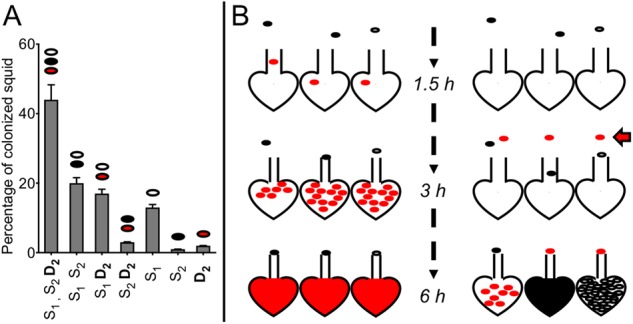Fig. 6.

a The composition of symbiont populations in squid inoculated with three strains. Animals were first exposed to an inoculum of two S strains (S1 and S2; black and white ovals); after 3 h, strain D2 (red ovals) was added. After 72 h, we determined the percentage of colonized squid that had one of the 6 possible combinations of the three inoculated strains. One hundred squids were analyzed in three replicates. The graph represents the mean percentage, and the error bars the 95% confidence intervals. b Model for the colonization of a light organ’s crypts with a mixture of S and D strains. Two scenarios are given (left and right panels) indicating how the crypts might become colonized, depending on when the host encounters the two kinds of strains. Each scenario is illustrated using three crypts that depict different possible trajectories for the progression of colonization: (i) when all three strains (S1, S2 and D2) are added at the same time (left panel), the D strain will migrate more rapidly than the S strains, which cannot reach the deep crypts before they have been colonized, and the bottleneck has been closed by the host in response to the presence of bacteria in the crypt [30]; (ii) when there is a sequential encounter of strains (right panel), S strains have the opportunity to migrate into and colonize at least some crypts, while D strains encountered 3 h later (red arrow) can only colonize any remaining empty crypts whose bottleneck has not been closed
